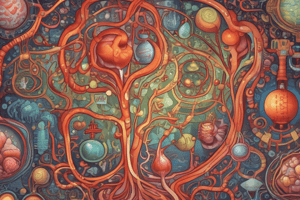Podcast
Questions and Answers
Which of the following is true for all exergonic reactions?
Which of the following is true for all exergonic reactions?
- The products have more total energy than the reactants.
- A net input of energy from the surroundings is required for the reactions to proceed.
- The reaction proceeds with a net release of free energy. (correct)
- The reactions are rapid.
- The reaction goes only in a forward direction: all reactants will be converted to products, but no products will be converted to reactants.
Which of the following best describes enthalpy (H)?
Which of the following best describes enthalpy (H)?
- The total kinetic energy of a system
- The cell's energy equilibrium
- The heat content of a chemical system (correct)
- The system's entropy
- The condition of a cell that is not able to react
Why is ATP an important molecule in metabolism?
Why is ATP an important molecule in metabolism?
- It provides energy coupling between exergonic and endergonic reactions. (correct)
- It is one of the four building blocks for DNA synthesis.
- Its hydrolysis provides an input of free energy for exergonic reactions.
- Its terminal phosphate bond has higher energy than the other two.
- Its terminal phosphate group contains a strong covalent bond that, when hydrolyzed, releases free energy.
Which of the following is most similar in structure to ATP?
Which of the following is most similar in structure to ATP?
Which of the following statements is true concerning catabolic pathways?
Which of the following statements is true concerning catabolic pathways?
What is the difference (if any) between the structure of ATP and the structure of the precursor of the A nucleotide in RNA?
What is the difference (if any) between the structure of ATP and the structure of the precursor of the A nucleotide in RNA?
Which of the following statements is true about enzyme-catalyzed reactions?
Which of the following statements is true about enzyme-catalyzed reactions?
Reactants capable of interacting to form products in a chemical reaction must first overcome a thermodynamic barrier known as the reaction's:
Reactants capable of interacting to form products in a chemical reaction must first overcome a thermodynamic barrier known as the reaction's:
A solution of starch at room temperature does not readily decompose to form a solution of simple sugars because:
A solution of starch at room temperature does not readily decompose to form a solution of simple sugars because:
Which of the following statements regarding enzymes is true?
Which of the following statements regarding enzymes is true?
Flashcards
Exergonic Reactions
Exergonic Reactions
Exergonic reactions release free energy during the reaction, meaning the products have less free energy than the reactants. Think of a ball rolling downhill: it releases energy as it moves.
Enthalpy (H)
Enthalpy (H)
Enthalpy is the total heat content of a system. Think of it as the energy stored in the chemical bonds within a system.
ATP's Role in Metabolism
ATP's Role in Metabolism
ATP is the energy currency of the cell, coupling energy-releasing (exergonic) reactions to energy-requiring (endergonic) reactions. Think of ATP as a battery charging other processes in the cell.
ATP and RNA Nucleotide Similarity
ATP and RNA Nucleotide Similarity
Signup and view all the flashcards
Catabolic Pathways
Catabolic Pathways
Signup and view all the flashcards
ATP and RNA Precursor Structure
ATP and RNA Precursor Structure
Signup and view all the flashcards
Enzyme-catalyzed Reactions
Enzyme-catalyzed Reactions
Signup and view all the flashcards
Activation Energy
Activation Energy
Signup and view all the flashcards
Starch Decomposition
Starch Decomposition
Signup and view all the flashcards
Enzyme Function
Enzyme Function
Signup and view all the flashcards
Study Notes
Exergonic Reactions
- Exergonic reactions involve a net release of free energy.
- Products have less energy than the reactants in these reactions.
Enthalpy (H)
- Enthalpy refers to the heat content of a chemical system.
- It is essential for understanding energy changes during reactions.
Role of ATP in Metabolism
- ATP is key for energy coupling between exergonic and endergonic reactions.
- Its hydrolysis releases necessary free energy for cellular processes.
Structure Similarity of ATP
- ATP structure is most similar to that of an RNA nucleotide.
- Both share a common structure with a nucleotide base, sugar, and phosphate groups.
Catabolic Pathways
- Catabolic pathways supply energy, primarily in ATP form, for cellular work.
- These pathways break down complex molecules into simpler ones, releasing energy.
Structure of ATP vs. RNA Nucleotide Precursor
- ATP and its precursor nucleotide in RNA share identical structures.
- They differ only in the number of phosphate groups attached to the sugar.
Enzyme-Catalyzed Reactions
- Enzymes increase the reaction rate by lowering the activation energy barrier.
- Reactions proceed faster with enzymes compared to without them.
Activation Energy
- Reactants must overcome the activation energy to form products in a reaction.
- The activation energy is crucial for understanding reaction spontaneity and rates.
Starch and Sugar Decomposition
- Starch does not decompose to sugar easily at room temperature due to a high activation energy barrier.
- This barrier prevents the hydrolysis of starch without significant energy input.
Enzymes and Reaction Rates
- Enzymes facilitate reactions by lowering activation energy without altering the free energy change.
- They do not change the equilibrium point but increase the speed of reaching it.
Studying That Suits You
Use AI to generate personalized quizzes and flashcards to suit your learning preferences.




